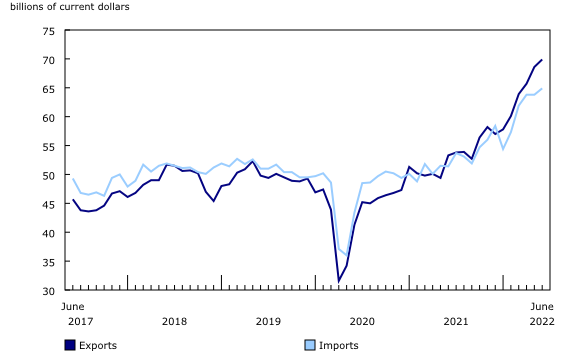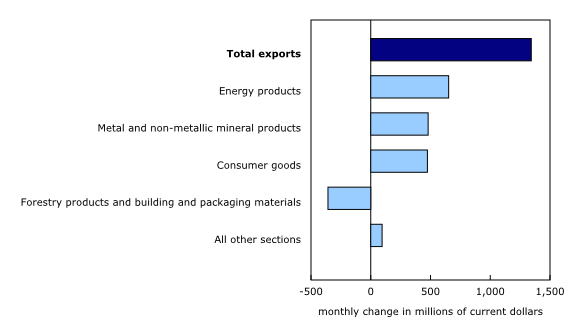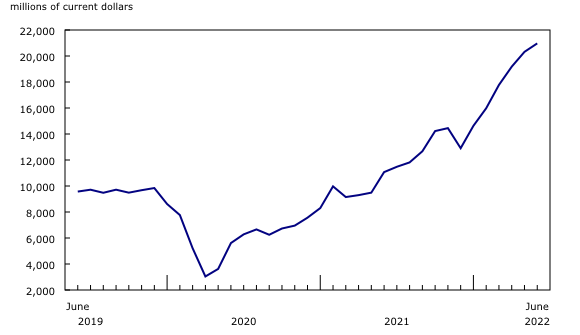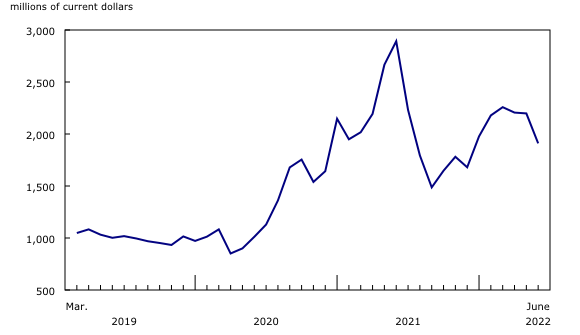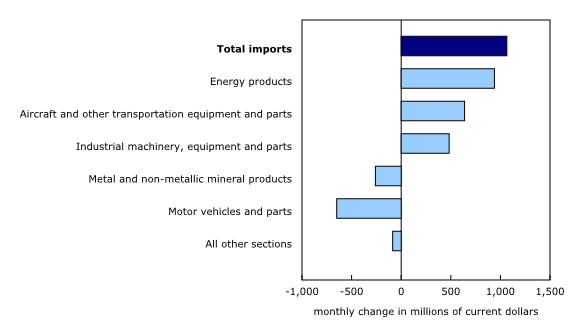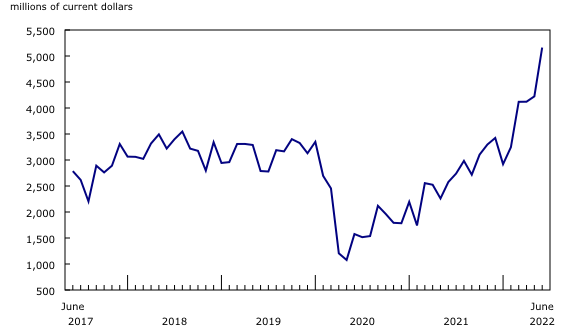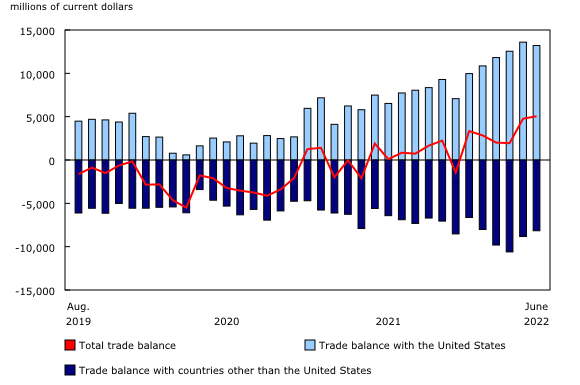Canadian international merchandise trade, June 2022
Released: 2022-08-04
In June, Canada's merchandise exports increased 2.0%, mostly on crude oil and gold exports. Meanwhile, imports rose 1.7%, mainly on energy products. As a result, Canada's merchandise trade surplus with the world widened from $4.8 billion in May to $5.0 billion in June.
Consult the "International trade monthly interactive dashboard" to explore the most recent results of Canada's international trade in an interactive format.
Exports continue to rise, posting a sixth consecutive increase
Total exports rose 2.0% in June to $69.9 billion, with 8 of 11 product sections posting increases. This was the sixth consecutive monthly increase for Canadian exports, the first time this has happened since 2013. In real (or volume) terms, exports were up 2.2%, meaning that export prices declined in June overall. This was the first decline in export prices since December 2021.
In June, exports of energy products increased 3.2% to $21.0 billion, representing a share of 30.0% of total exports for the month, a record high for this product section. Exports of crude oil and bitumen (+3.7%) posted the largest increase in June, largely on higher volumes. Prices for crude oil exports also rose in June, a sixth consecutive monthly increase. While energy products were important to the gain in total exports, non-energy exports were also up (+1.4%) in June. This was also the sixth consecutive monthly gain for non-energy products.
Exports of metal and non-metallic mineral products rose 6.5% in June. Exports of unwrought gold, silver, and platinum group metals, and their alloys (+29.2%)—a category mainly composed of unwrought gold—contributed the most to the monthly gain in this product section. The growth observed in June was mainly because of an increase in exports of refined gold to the United Kingdom.
Exports of consumer goods (+6.3%) also contributed to the rise in total exports in June, mainly as a result of the strong increase in exports of pharmaceutical products (+34.0%). In June, large quantities of medications for the treatment of COVID-19 were exported to the United States, Australia and the Netherlands.
A decrease in exports of forestry products and building and packaging materials (-6.6%) partly offset those gains. This decline was largely attributable to a decrease in the value of lumber exports (-13.1%), mainly on lower prices. As explained in the release of June data for the Industrial Product Price Index, the decline in lumber prices is in large part the result of a decrease in demand from the construction industry in the United States, where housing starts in May posted their most severe decline in over two years.
Energy products contribute the most to the increase in imports
Total imports rose 1.7% in June to $64.9 billion, a fifth consecutive monthly gain. The increase occurred while more product sections posted declines than gains. In real (or volume) terms, total imports edged down 0.3%, meaning that the increase in nominal imports in June was mainly because of higher prices.
Imports of energy products (+22.3%) contributed the most to the gain in total imports in June. Imports of refined petroleum products rose 32.5% to a record high of $1.9 billion. Although prices of refined petroleum products rose, over half of the growth was attributable to higher volumes. In June, significant growth was observed in imports of motor gasoline (including blending components and ethanol fuel) from the United States and the United Kingdom. Crude oil imports (+20.8%) also rose, mainly on higher volumes imported from the United States. Finally, imports of natural gas rose 35.2% in June, largely on higher prices.
Imports of aircraft and other transportation equipment and parts were up 39.7% in June. Following a decrease of $348 million in May, imports of aircraft (+$415 million) contributed the most to the monthly growth in June for this product section. This gain was because of an increase in imports of commercial airliners from the United States. Imports of ships, locomotives, railway rolling stock and rapid transit equipment (+$288 million) also posted a significant increase in June, more than quadrupling on imports of oil tankers.
Lower imports of motor vehicles and parts (-6.8%) partially offset the increase in total imports. After an increase of 19.1% in May, imports of passenger cars and light trucks (-11.2%) was largely responsible for the decrease in June, in part because of the decline in imports from South Korea and Germany. Global motor vehicle production continues to be affected by supply chain issues, resulting in stronger monthly variations in the trade of these goods.
Trade surplus with the United States remains at a historic level
Exports to the United States rose 1.2% in June, while imports from the United States were up 2.6%. As a result, Canada's trade surplus with the United States narrowed from $13.6 billion in May to $13.2 billion in June, still the second-highest surplus on record.
When the average exchange rates for May and June are compared, the Canadian dollar gained 0.2 US cents relative to the American dollar.
Exports to countries other than the United States rise
In June, exports to countries other than the United States rose 4.5% compared with May, to a record high of $16.4 billion. Exports to China (coal, copper and potash), Australia (pharmaceutical products) and the Netherlands (pharmaceutical products) posted the largest increases.
Imports from countries other than the United States edged up 0.2% in June. The rise in imports from India (various products), the United Kingdom (motor gasoline), Switzerland (non-ferrous metals) and Brazil (various products) was almost entirely offset by the decline in imports from Germany (motor vehicles) and Saudi Arabia (crude oil).
The merchandise trade deficit with countries other than the United States narrowed from $8.8 billion in May to $8.2 billion in June.
Energy products responsible for over half of the quarterly increase in exports
Total nominal exports rose 12.3% in the second quarter, the strongest gain since the third quarter of 2020. Exports of energy products (+25.0%) accounted for over half of the growth in the second quarter. The value of energy product exports has more than doubled since the second quarter of 2021. All other product sections posted quarterly gains, but considerably smaller ones than those of energy products.
Quarterly merchandise imports rose 10.9% in the second quarter. In contrast to exports, the increase in imports was widespread across various product sections. Energy products (+31.3%), motor vehicles and parts (+12.9%), and consumer goods (+8.3%) each posted a quarterly increase of over $3 billion and contributed the most to the growth in total imports.
Canada's merchandise trade surplus with the rest of the world widened from $8.2 billion in the first quarter to $11.8 billion in the second quarter.
Lower quarterly gains in constant dollars for exports
Exports in constant dollars (calculated using 2012 chained dollars) rose 2.3% in the second quarter of 2022. The increases observed in 8 of the 11 product sections were partly offset by the decline in energy product exports (-3.0%) in constant dollars.
Quarterly imports in constant dollars rose 6.7% in the second quarter. Motor vehicle and parts imports (+11.4%) posted the largest gain.
While total imports in constant dollars are well above pre-COVID-19 pandemic levels, exports remain below their pre pandemic mark.
Revisions to May merchandise export and import data
Imports in May, originally reported at $63.1 billion in the previous release, were revised to $63.8 billion in the release for the current reference month. Exports in May, originally reported at $68.4 billion in the previous release, were revised to $68.6 billion in the current reference month's release.
Monthly trade in services
In June, monthly service exports rose 1.5% to $12.8 billion. Meanwhile, service imports increased 2.8% to $14.0 billion.
When international trade in goods and international trade in services were combined, exports increased 1.9% to $82.7 billion in June, while imports were up 1.9% to $78.9 billion. As a result, Canada's trade surplus with the world went from $3.7 billion in May to $3.8 billion in June.
Note to readers
Merchandise trade is one component of Canada's international balance of payments (BOP), which also includes trade in services, investment income, current transfers, and capital and financial flows.
International trade data by commodity are available on both a BOP and a customs basis. International trade data by country are available on a customs basis for all countries and on a BOP basis for Canada's 27 principal trading partners (PTPs). The list of PTPs is based on their annual share of total merchandise trade—imports and exports—with Canada in 2012. BOP data are derived from customs data by adjusting for factors such as valuation, coverage, timing and residency. These adjustments are made to conform to the concepts and definitions of the Canadian System of National Accounts.
For a conceptual analysis of BOP-based data versus customs-based data, see "Balance of Payments trade in goods at Statistics Canada: Expanding geographic detail to 27 principal trading partners."
For more information on these and other macroeconomic concepts, see the Methodological Guide: Canadian System of Macroeconomic Accounts (13-607-X) and the User Guide: Canadian System of Macroeconomic Accounts (13-606-G).
The data in this release are on a BOP basis and are seasonally adjusted. Unless otherwise stated, values are expressed in nominal terms, or current dollars. References to prices are based on aggregate Paasche (current-weighted) price indexes (2012=100). Movements within aggregate Paasche prices can be influenced by changes in the share of values traded for specific goods, with sudden shifts in trading patterns—as observed currently with the COVID-19 pandemic—sometimes resulting in large movements in Paasche price indexes. Volumes, or constant dollars, are calculated using the Laspeyres formula (2012=100), unless otherwise stated.
For information on seasonal adjustment, see Seasonally adjusted data – Frequently asked questions.
Revisions
In general, merchandise trade data are revised on an ongoing basis for each month of the current year. Current-year revisions are reflected in both the customs-based and the BOP-based data.
The previous year's customs-based data are revised with the release of data for the January and February reference months, and thereafter on a quarterly basis. The previous two years of customs-based data are revised annually, and revisions are released in February with the December reference month.
The previous year's BOP-based data are revised with the release of data for the January, February, March and April reference months. To remain consistent with the Canadian System of Macroeconomic Accounts, revisions to BOP-based data for previous years are released annually in December with the October reference month.
Factors influencing revisions include the late receipt of import and export documentation, incorrect information on customs forms, the replacement of estimates produced for the energy section with actual figures, changes in merchandise classification based on more current information, and changes to seasonal adjustment factors. The seasonal adjustment parameters are reviewed and updated annually, and applied with the October reference month release.
For information on data revisions for exports of energy products, see Methodology for Exports of Energy Products within the International Merchandise Trade Program.
Revised data are available in the appropriate tables.
Real-time data table
The real-time data table 12-10-0120-01 will be updated on August 15.
Next release
Data on Canadian international merchandise trade for July will be released on September 7.
Products
The product "International trade monthly interactive dashboard" (71-607-X) is now available. This new interactive dashboard is a comprehensive analytical tool that presents monthly changes in Canada's international merchandise trade data on a balance-of-payments basis, fully supporting the information presented every month in the Daily release.
The product "The International Trade Explorer" (71-607-X) is now available online.
The Canadian International Merchandise Trade online database is no longer available. It has been replaced by the Canadian International Merchandise Trade Web Application (71-607-X), a modern tool that provides trade data users with a number of enhancements.
The updated "Canada and the World Statistics Hub" (13-609-X) is now available online. This product illustrates the nature and extent of Canada's economic and financial relationship with the world using interactive charts and tables. It provides easy access to information on trade, investment, employment and travel between Canada and a number of countries, including the United States, the United Kingdom, Mexico, China, Japan, Belgium, Italy, the Netherlands and Spain.
Contact information
For more information, or to enquire about the concepts, methods or data quality of this release, contact us (toll-free 1-800-263-1136; 514-283-8300; infostats@statcan.gc.ca) or Media Relations (statcan.mediahotline-ligneinfomedias.statcan@statcan.gc.ca).
- Date modified:


